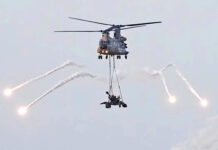Indicating the government’s priority to internal security, Finance Minister Nirmala Sitharaman, in the Budget for 2023-24, has allocated Rs 1.96 lakh crore to the Ministry of Home Affairs (MHA) with a special focus on expenditure on Central Armed Police Forces (CAPFs) having an outlay of Rs 1,27,756.74 crore.
The Allocations were as follows:
Rs 31,772.23 crore – Central Reserve Police Force (CRPF).
Rs 24,771.28 crore – Border Security Force (BSF).
Rs 13,214.68 crore – Central Industrial Security Force (CISF).
Rs 8,096.89 crore – Indo-Tibetan Border Police (ITBP).
Rs 8,329.10 crore – Seema Suraksha Bal (SSB).
Rs 7,052.46 crore – Assam Rifles (AR).
Rs 1,286.54 crore – National Security Guard (NSG)
Total Rs 1.27 lakh crore earmarked for paramilitary forces.
The allocations made to the ministry, headed by Union Home Minister Amit Shah, according to the Budget document, is higher by over Rs 10,000 crore, as in the Budget for 2022-23, it was pegged at Rs 1,85,776.55 crore.
The bulk of the amount allocated to the MHA, Rs 1,27,756.74 crore, has been earmarked for the CAPFs in comparison to Rs 1,19,070.36 crore in 2022-23.
Among the CAPFs, the Central Reserve Police Force (CRPF), mostly responsible for internal security duties and fighting militancy in Jammu and Kashmir, has been allocated Rs 31,772.23 crore in comparison to Rs 31,495.88 crore given in 2022-23.
The Border Security Force (BSF), which guards India’s border with Pakistan and Bangladesh, besides handling internal security assignments, has been given Rs 24,771.28 crore in comparison to Rs 23,557.51 crore given in the current financial year.
The Central Industrial Security Force (CISF), which protects vital installations such as nuclear projects, airports and metro networks, has been given Rs 13,214.68 crore in comparison to Rs 12,293.23 crore allocated in 2022-23.
The Shashastra Seema Bal (SSB), which guards India’s borders with Nepal and Bhutan, has been allocated Rs 8,329.10 crore in comparison to Rs 8,019.78 crore given in 2022-23.
The Indo-Tibetan Border Police (ITBP), which guards India’s borders with China, got Rs 8,096.89 crore in comparison to Rs 7,626.38 crore given in the current fiscal.
The Assam Rifles, which is deployed along the India-Myanmar border and for anti-insurgency duties in the North-East, has been allocated Rs 7,052.46 crore in comparison to Rs 6,561.33 crore given in the current financial year.
The National Security Guard (NSG), the elite commando force to tackle any emergency security situation, has been allocated Rs 1,286.54 crore in comparison to Rs 1,183.80 crore given in 2022-23.
Expectations
What the CAPFs expected from the 2023 Union budget was funds for infrastructure development in border areas, better equipment with latest technology for disaster management, training and operations and a robust communication system.
Each year funds for the CAPFs see only a marginal increase, most of which goes into salaries, allowances and other wages, with only a little left over for the development and modernisation of the organisation.
Although a separate fund is also earmarked for modernisation of the forces, focus on infrastructure development and better training and equipment, is often ignored owing to lack of funds.
In the previous budget, in 2022, the Ministry of Home Affairs was allocated Rs 1,85,776.55 crore – a more than 11 per cent increase over the Rs 1,66,547 crore allotted in the previous fiscal year.
Last year, as a new feature, funds were allocated for the modernisation of the CAPF, to equip the forces with modern, state-of-the-art weapons and equipment, according to their operational requirement, keeping in view their deployment pattern in different sectors. Besides, upgraded IT solutions were also to be provided to CAPF. The plan announced a total financial outlay of Rs.1,523 crore between 1 February 2022 and 31 March 2026.
The National Disaster Response Force (NDRF) and Delhi Police, both of which also roll up to the Ministry of Home Affairs, also had similar expectations from the budget.
With climate change there has been an increase in episodes of natural disasters, which requires the latest technology relief operations and the next budget should focus on that.


















